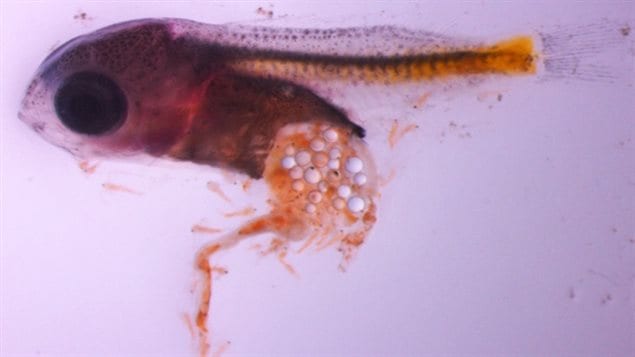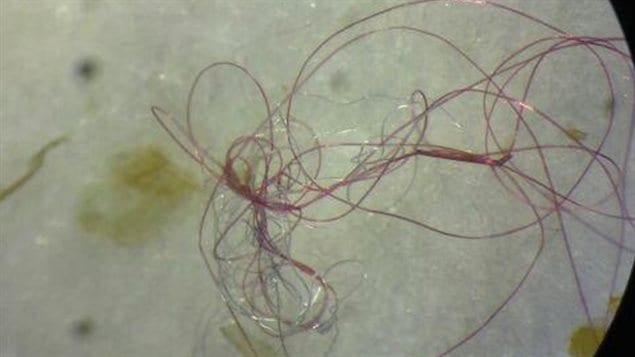Microplastics Effects on Bivalves; Clams, Oysters, Mussels
"We're finding most shellfish have plastic in them."
"Shellfish aquaculture uses a lot of plastic infrastructure."
"I wouldn't be overly concerned about eating shellfish specifically. Microplastics are everywhere."
"The ability of microplastics to absorb and concentrate chemicals that may be eaten by organisms makes them a serious emerging threat to wildlife and natural ecosystems and potentially, human health."
"We are looking at shellfish because they are filter-feeding organisms. They accumulate anything that is in the water and they live on the coast where the most drastic changes are happening, which makes them excellent sentinels of ecosystem health."
Dr. Sarah Dudas, Canada Research Chair in Shellfish Aquaculture Ecosystem,Vancouver Island University, Nanaimo, British Columbia
 |
| A larval perch with microplastic in its gut. Vancouver Island University
professor Sarah Dudas says the effects of microplastics still aren’t
fully understood, but they are believed to have impacts on the
reproductive abilities of fish. Photo Credit: (Oona Lönnstedt) |
"Microplastics are an added factor to plastic pollution. The beading in toothpaste, confetti from parades, the glitter people put on their faces, the sources are endless and the hardest part is educating people about it."In 2016, Dr. Dudas assembled a team of students to help her analyze the contents of thousands of clams and oysters found in the Strait of Georgia. Their study affirms that in consuming clams or oysters, a decided seafood delicacy appreciated by many people for their delicious taste and nutrient utility along with the protein inherent in their constituency, is an unexpected and decidedly un-nutritious element, plastic.
"Since I started the project I’ve been going home and talking to my friends and family about this. I want to get the word out and start them thinking about where the plastic products they buy end up." "Shellfish are resilient so I ask myself, if they are being affected by microplastics then what are the microplastics doing to the more vulnerable organisms in the oceans?"
Maggie Dietterle, university student, research study
Correct, plastic. The same substance in various forms found contaminating and polluting the earth and the oceans everywhere from the tropics to the Arctic regions of the two poles. On land the presence of plastics represent an existential threat to wildlife, killing many which become trapped, or attempt to ingest it in its various forms, and in the oceans, even whales are known to die from having consumed plastic which their alimentary canals cannot process, and which in any event, provide them with no sustenance.
There are predictions that the rising tide of plastics everywhere on this planet will eventually pose an even steeper threat to the biosphere. Which hasn't yet put a brake on the use of plastics and their ubiquitousness in packing and containerizing, convenience and manufacturing of durable products. Durable indeed; their shelf life might not be long, but their capacity to endure without breaking down in the environment is endless.
According to Dr. Dudas, the research her team has been engaged in finds no differences in the plastics discovered in fish, whether the aqua-creatures are those raised in commercial fish farming or those found in the wild. Her study, as with that of the Vancouver Aquarium's Ocean Pollution Research Program, have come up thus far with no solution to the question looking for a definitive answer as to a source.
While it is true that fish aquaculture uses plastic extensively in the manufacture of nets and ropes that with use shed flake fibres, identifying with any degree of accuracy what it is that pollutes fish habitat remains elusive. Other than the generalized fact that plastics in various presentations are not just in garbage landfills, but carelessly strewn about, blown about, everywhere.
 |
The preliminary results of Dr. Dudas's study indicate the existence of an average of eight microplastic particles resident in each clam or oyster. Despite which, she is of the opinion that though these minuscule specks and strands of plastic are overwhelmingly everywhere, there should be little concern over eating the shellfish containing them. Doubtless, given the presence of plastics everywhere they end up in some invisible form in everything we eat.
Remember the scandal out of China in 2008 when it was discovered that powdered plastic (melamine) had been put in baby formula and other foods which had been adulterated, (even fed to animals and appearing in eggs) with the end result that some babies died because of their intake of formula whose manufacturers used the plastic to have their product appear more wholesome.
 |
Labels: Aquaculture, Bioscience, Health, Plastics, Research

0 Comments:
Post a Comment
<< Home